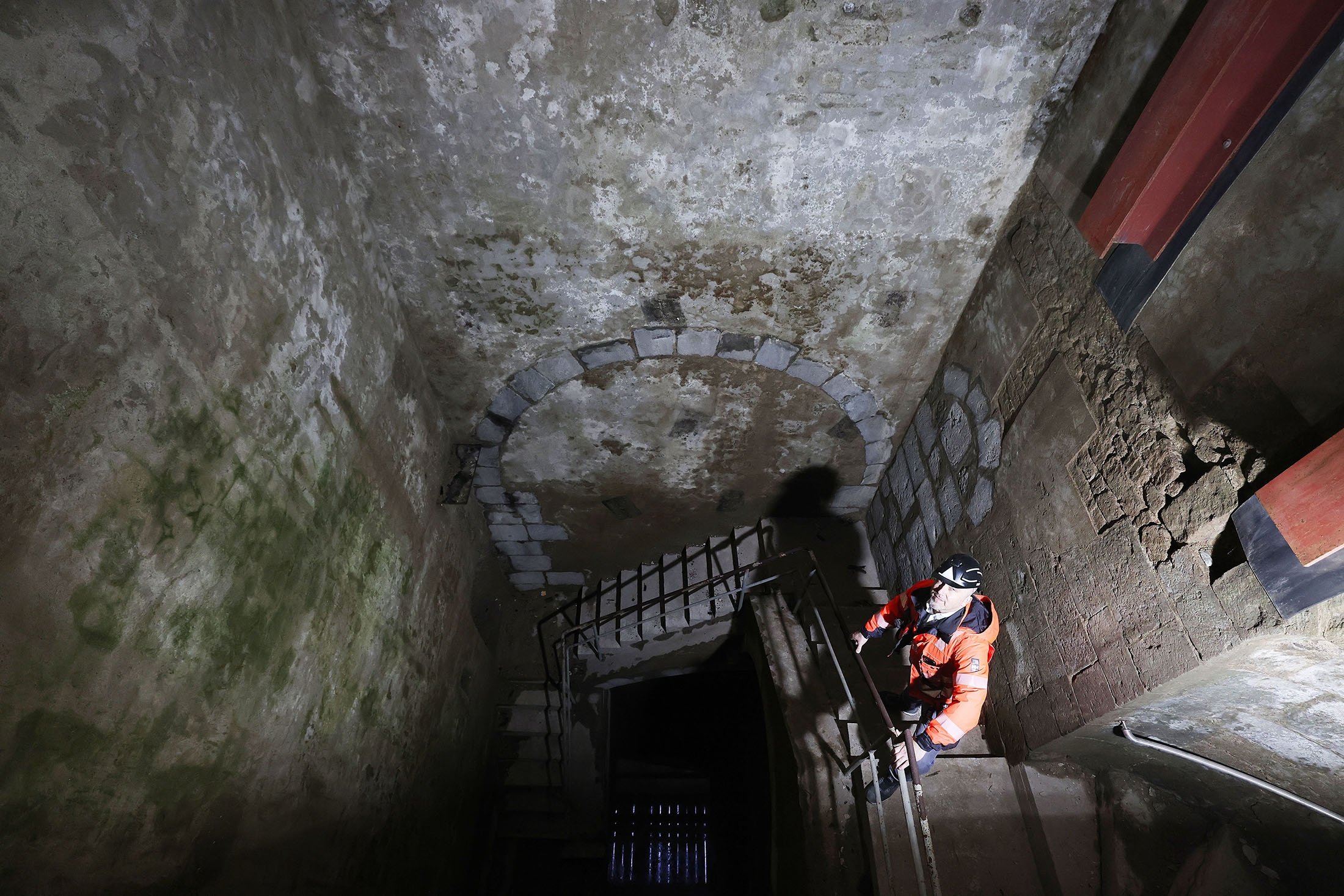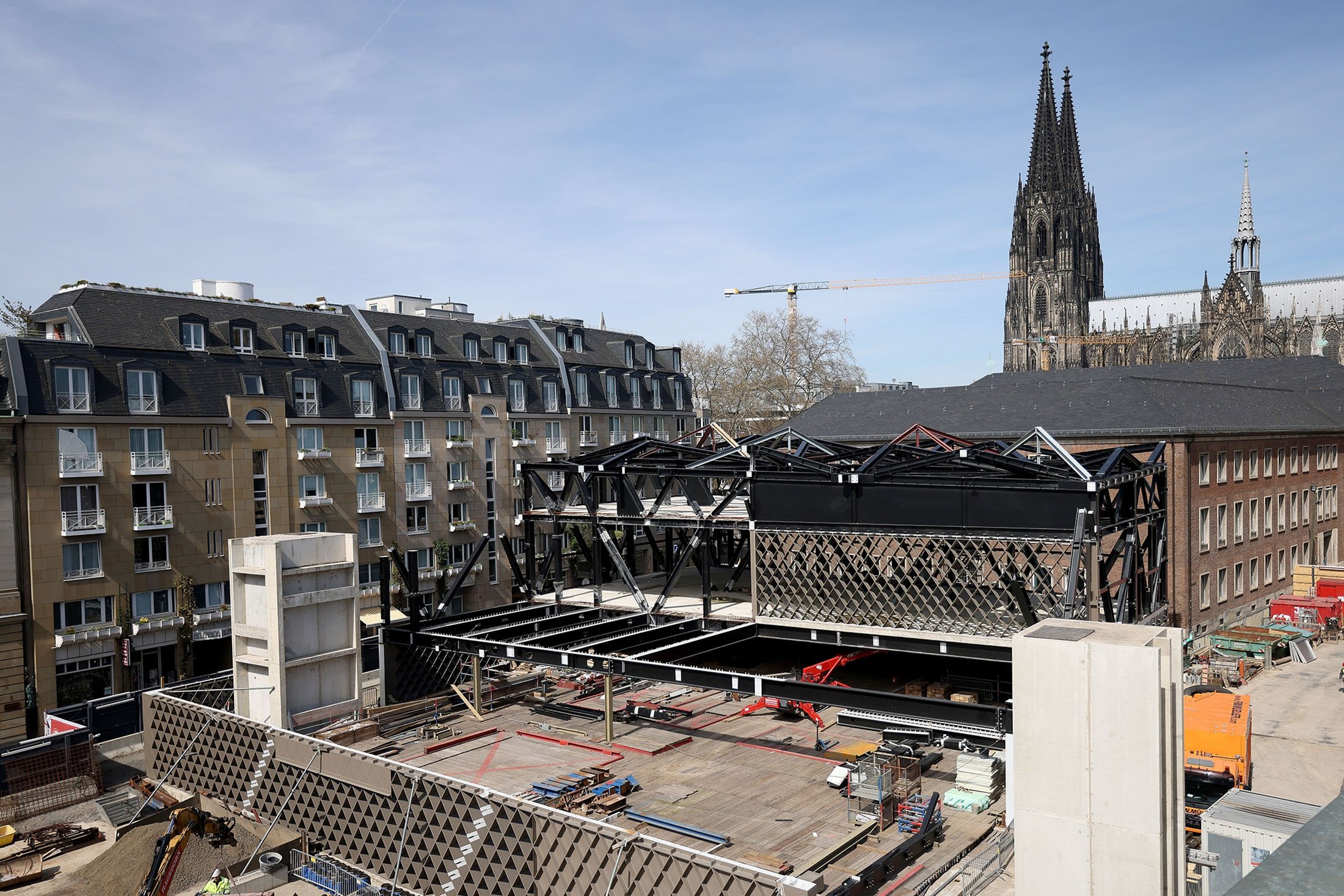© Turkuvaz Haberleşme ve Yayıncılık 2026
Located 14 meters (45.9 feet) underground in Germany's Cologne, a 600 meter subterranean tunnel connects two historic sites – a Roman palace and the city's medieval Jewish quarter – in a new, underground Jewish Museum set to open soon.
It looks like the tower of a castle, with stairs leading down the wall and a glimmer of black water below. This is the mikvah, the ritual bath of Cologne's medieval Jewish community. The museum, located close to Cologne's famous cathedral, is unlike any other. Called MiQua in reference to the mikvah, it will feature a 600-meter route from the ruins of the Roman governor's palace for Lower Germania – now a UNESCO World Cultural Heritage site – through the medieval Jewish quarter.
It all feels a lot like Indiana Jones, aside from the fact that it is all real.
All this is the work of archaeologists and it is still in process, with an opening date yet unclear.

They are still busy, their work accessible through a rickety ladder behind construction fences. Here in their parallel world, British archaeologist Gary White explains the dig covers 2,000 years of history. "You wouldn't find that anywhere else," he says, adding that for him, it is "like a reward for my whole life as an archaeologist."
Cologne has a long history that starts with Agrippa, the general of the Emperor Augustus and friend of biblical King Herod. Back in 19 B.C., he resettled the Roman-friendly Ubian people on the left bank of the Rhine, roughly where White is now standing.
Since then, Germany's westernmost city was repeatedly destroyed and rebuilt over the past 2,000 years, meaning each new version of Cologne is built upon an earlier iteration of the city.
To find out more about the previous versions of Cologne, you have to head underground. Sometimes, traces of the past come to the surface, as after the Second World War when the ruins of the Praetorium, the governor's palace, suddenly appeared out of craters left by bombs. The ruins are now being integrated into the museum that is currently under construction.
More recently, archaeologists made the breakthrough to the medieval Jewish quarter, only rediscovered this century.

Below ground, you see Roman and medieval walls that intersect, showing how people in the past were in the habit of taking stones from older buildings to create new structures in the absence of quarries for fresh material.
"Watch your heads," says site manager Matthias Zoppelt leading the group down a narrow corridor. We see two archaeologists working with a spotlight, a larger room with a well-preserved Roman archway behind them.
We are standing on the site of what was an inn during the Middle Ages, located in the Jewish quarter.
Cologne's Jewish community, the oldest north of the Alps, wasn't a ghetto, but a city within the city, with a synagogue, the mikveh ritual bath, a dance hall and a bakery.
The miniature world is now suddenly back again albeit underground and in ruins, though it is again possible to walk through the houses. "There in front was the Haus zum Golde, then comes Haus Nichols, Haus Koppe, Haus Bardowick and finally Haus Nussia," says archaeologist Michael Wiehen, as though he is pointing out the homes of his next door neighbors.
Further on, he points to a sign with a Hebrew inscription, calling it a "truly unique find." "We are here in the Lyvermann house." Lyvermann was a Jew from Düren who had his house here in the 13th century and even had a toilet.

There was a problem, however. "Above the latrine is the courtyard that runs around the synagogue," says Wiehen. "This is a sacred area that must not be polluted. Latrines were normally cleaned from above, but this would have allowed feces to enter the synagogue courtyard. That was not allowed."
He says Mr Lyvermann found a clever solution. Rather than emptying the latrine from above, it was emptied through the cellar. Lyvermann also created the sign with instructions for others. The inscription translates as "This is the window through which the excrement is taken out."
That's probably as close as you can get to the Middle Ages.
So far, the archaeologists have unearthed several hundred thousand objects, including a crescent-shaped, gemstone-studded gold earring from the 11th century and a tablet with the inscription "yt in ys neyt anders," which you could translate as "Et is, wie et is," ("It is what it is"), a classic Cologne saying that you still find on fridge magnets sold in the city. Finds like this show that for centuries the Jews were simply Cologne residents like any other in the city, although that was to change abruptly, as further finds show.
Wiehen shows some black-grey chunks of metal that he says are fragments of iron chainmail that melted in a fire that burned at a temperature of more than 1,100 degrees Celsius (2,012 degrees Fahrenheit).
He dates the fire as occurring on Aug. 24, 1349, when Jewish life in Cologne, the largest city in Germany, suddenly ended.
That was the year that the plague broke out, crossing the Alps and approaching Cologne from the south. With it came rumors that Jews had brought on the plague by poisoning the wells.
On that fatal night, a mob stormed over the wall that marked the Jewish area, burning down people's homes and killing men, women and children.
White calls the remains "Pogrom debris," the most important find of all. He shows us written slates from the synagogue school, shopping lists, pictures, graffiti and a particularly moving relic.
Kept in a small box, it is a delicate flower carved out of stone that was once part of the synagogue's richly decorated reading pulpit before it was smashed into thousands of pieces that night.
"It is very reminiscent of the architecture in Cologne Cathedral," says Wiehen.
The researchers surmise that the flower was created by one of the Christian stonemasons who were part of the cathedral's construction lodge, showing how closely were the links between the two religions – as well as the fragility of that connection.
